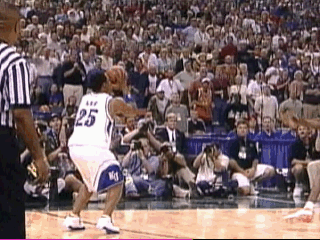Orange fans hopes are very high for the upcoming men’s
basketball season. There indeed is a lot
of potential on this squad, and the team may go ten players deep, something that
has not happened often in coach Jim Boeheim’s career.
It is with almost certainty that the Orange will be a better
team this year than the squad from last year.
But fans must keep in mind that last year’s team, before the NCAA
tournament, may have been one of the worst squads that Boeheim has ever
had. The team was 19-13 in the regular
season, and was 5-6 versus AP Top 25 teams.
That record was deservedly good enough to get into the NCAA tournament,
particularly with the strength of some of the Orange’s wins. But by Syracuse and Jim Boeheim standards, it
was a mediocre season. That is, until
the NCAA tournament, where the team jelled, and made an improbably run to the
Final Four.
It is also unlikely that no matter how good this year’s team
is, that they will not get to the Final Four.
Several of Syracuse’s top teams have never made the Final Four. Teams need to be playing very well as a unit,
and get the right match ups, plus have players step up when they need to.
This year’s team will be very hard to predict. There are a lot of questions about what the
squad really is comprised of. It does have a ton of potential.
Question 1: How good
will Tylor Lydon be this year? Last year
he was the #4 option on the offense,
and he was a terrible mismatch for
opposing teams. This year he will likely be the #1 option. He is still a
mismatch, but defenses will focus more on him.
Lydon has a terrific motor with a lot of hustle, and plays defense well.
He should be better this year than last.
Question 2: How good
are the centers? DaJuan Coleman is a
fifth year senior, beset by injuries throughout this career. He started to play
his best basketball in the NCAA tournament at the end of last year. While there is no expectation for him to be a
star, can he put up good numbers in 20-25 minutes of play? Similarly, what do the Orange have in Paschal
Chukwu? He is a 7’2” player with a great
wingspan and the ability to run the court.
He came as a raw talent and spent a year as a redshirt. Can he be the shot blocking force that fans
envision? Does he have the ability to
play defense other than blocking shots, and does he bring anything to the
offensive end of the court?
Question 3: Who will
play the point, and how solid will that play be? John Gillon and Frank Howard are the two
point guards for this season. Gillon is
reportedly very quick with an average perimeter shot, a great ability to push
the ball, and to press on defense. He is small, so he is not the prototypical
guard for the top of the zone, though his speed may compensate for that. Howard has the length to play the top of the
zone, and has played in Boeheim’s zone for a year. He showed last year that he is a terrific
passer, with a good ability to get to the hoop, but very limited shooting
range. Has his shooting improved?
Question 4: How will
the two fifth year seniors fit in? The
previously mentioned Gillon and Andrew White join Syracuse as graduate
transfers. White is reportedly a
terrific shooter, though NBA scouts did indicate he needed to stay in school
another year to develop more. The two
players have a ton of collegiate experience, and that brings a lot of
value. But both have no experience in
Boeheim’s system, and how well will they play zone defense? Do the personalities of both players allow them
to be ‘team players’, or are they going to be self-focused?
Question 5: How good
are the freshman? It seems that Tyus Battle is a terrific athlete and will see
a lot of time at the shooting guard position. Taureen Thompson will see some
time up front, and Matthew Moyer will try to find some time at the small
forward position. Do these players
adjust well to being secondary players, if necessary? Particularly of concern
would be Battle who may already have an eye on going to the NBA. Can the freshman deliver? For every Carmelo Anthony and Gerry McNamara,
you have a Tyler Roberson and Kaleb Joseph.
Question 6: Speaking
of Roberson, which Roberson will we see this year? Roberson did not make the big jump from his
sophomore to junior season that you often see with players. He still had a
limited shooting range, and most infuriating was that his effort and production
was inconsistent. There were nights of ‘plugged
in’ Roberson where he pulled down 20 rebounds against Duke. And then there were
nights that he barely registered in the stat column, frustrating Boeheim to the
point that he publicly criticized his lack of effort.
Question 7: How does
this team gel? Do the sum of the parts
exceed the components, or do the individual efforts exceed what the team
does? Great teams do the former; poorer
teams do the latter.
We have a Hall of Fame coach who loves his job, and is as
focused as ever. Boeheim is publicly praising
this team, and polls have the team in the top 20 preseason. I’d love for the parts to come together, for
the Orange to have a great season, one where the offense flowed well, and the
defense continued to shut-it-down.
We will start to find out November 11th.










